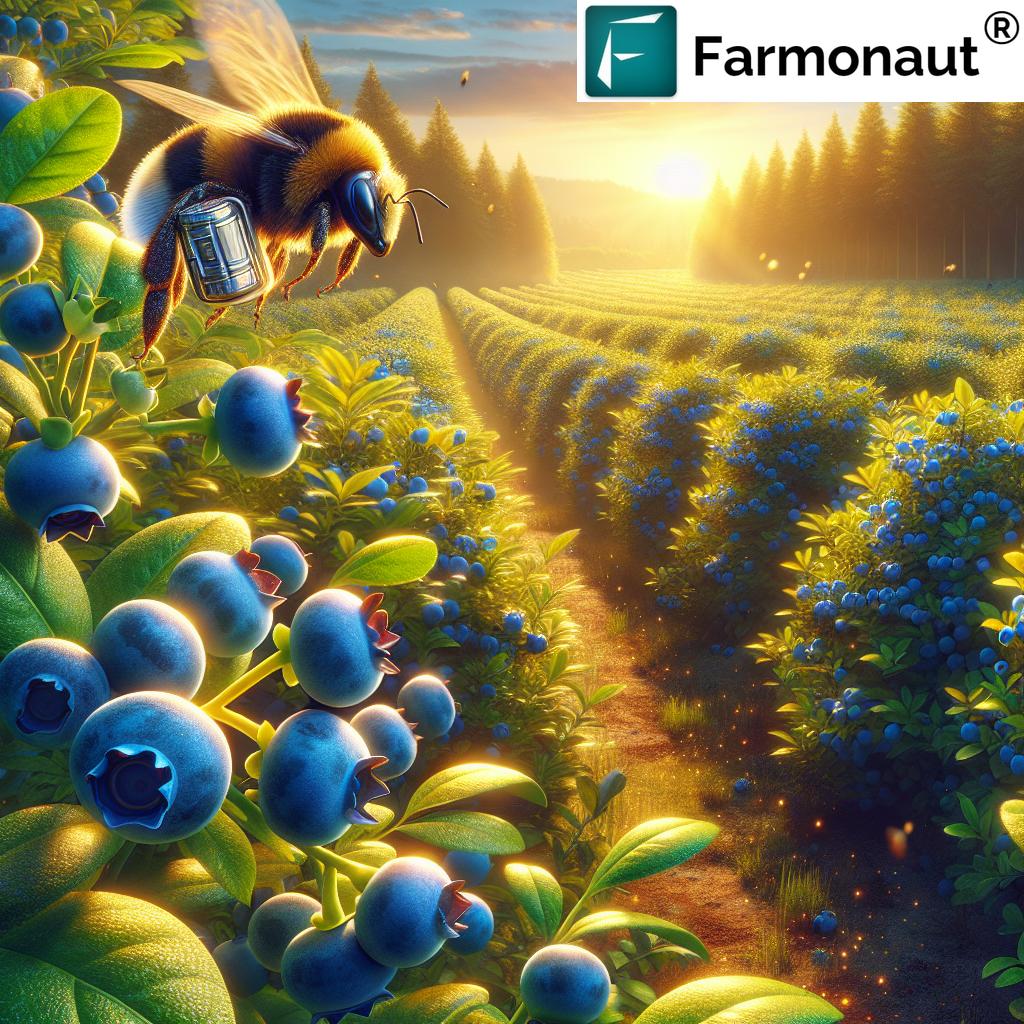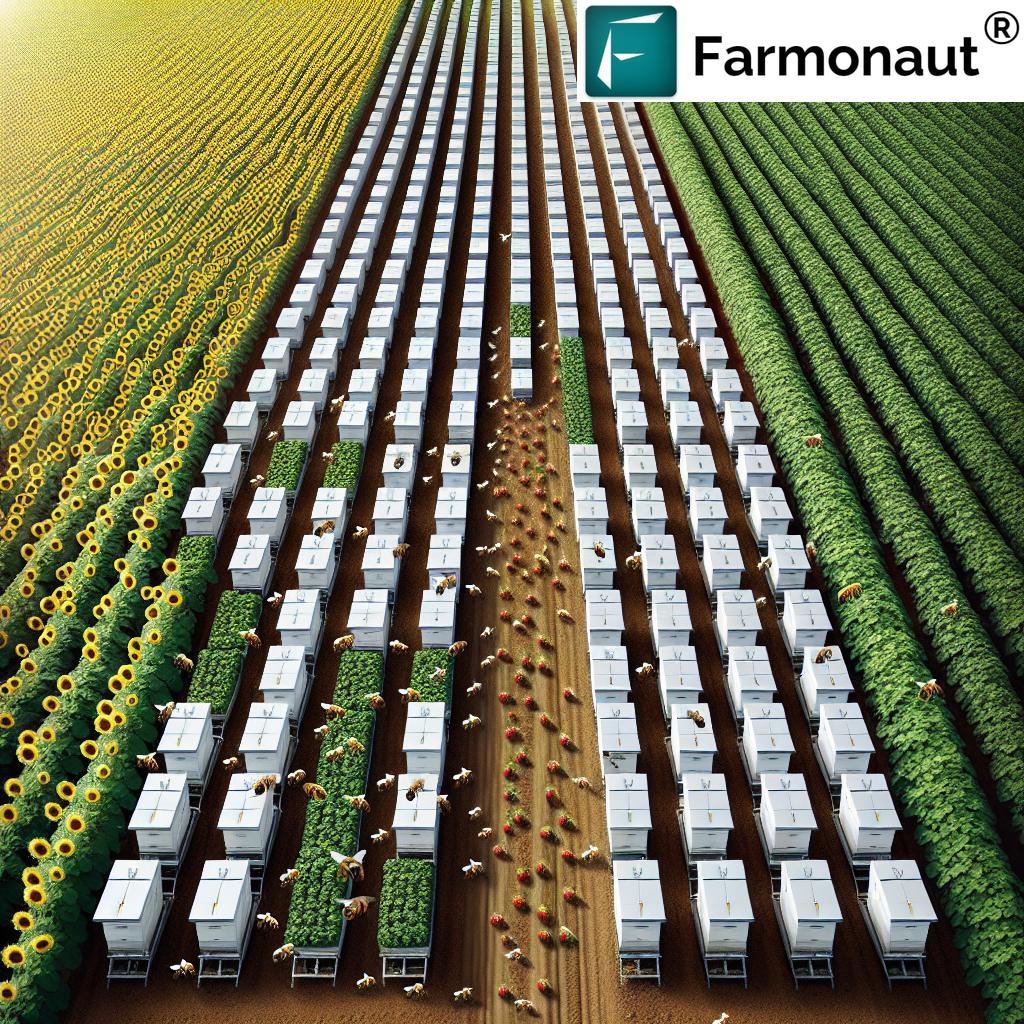Revolutionizing Sustainable Agriculture: How Bee Vectoring Technology is Transforming Crop Protection in Ontario
“Bee vectoring technology can reduce pesticide use by up to 95% in certain crops, promoting sustainable agriculture.”
In the heart of Ontario, Canada, a groundbreaking agricultural revolution is taking flight. Bee vectoring technology, an innovative sustainable agriculture technology, is transforming the way we approach crop protection and pest management. This blog post will explore how this cutting-edge solution is reshaping the landscape of farming practices, particularly in the fertile fields of Ontario.
Understanding Bee Vectoring Technology
Bee vectoring for crop protection is an ingenious method that harnesses the natural pollination behavior of bees to deliver targeted biological crop disease control agents directly to crops. This innovative agricultural solution represents a significant leap forward in our quest for more environmentally friendly farming practices.

The Science Behind Bee Vectoring
At the core of this technology lies a sophisticated understanding of bumblebee pollination systems. Here’s how it works:
- Specialized Hives: Commercial bumblebee hives are equipped with a proprietary dispenser system.
- Inoculum Delivery: As bees exit the hive, they pass through a tray containing a powder form of beneficial microbes (inoculum).
- Natural Distribution: The bees pick up this powder on their legs and bodies.
- Targeted Application: As they pollinate, the bees effectively deliver the inoculum directly to the flowers of the crops.
This precision agriculture technique combines the essential task of pollination with an innovative approach to crop disease control, offering an effective alternative to traditional chemical methods.
The Role of Active Ingredients
The active ingredients used in bee vectoring are carefully selected for their ability to:
- Stimulate plant growth
- Create barriers against common crop pathogens
- Enhance overall plant health
These ingredients are typically beneficial fungi or other microorganisms that work symbiotically with the plant to boost its natural defenses.
Applications in Ontario Agriculture
In Ontario, bee vectoring technology is making significant strides in protecting and enhancing various high-value crops, including:
- Blueberries
- Strawberries
- Caneberries (raspberries and blackberries)
- Sunflowers
- Apples
- Tomatoes
These crops benefit not only from improved pollination but also from the targeted delivery of natural pest management solutions.
Environmental Benefits
One of the most compelling aspects of bee vectoring is its positive environmental impact. By reducing the need for chemical pesticides, this technology supports:
- Biodiversity conservation
- Soil health preservation
- Water quality protection
- Pollinator population support
These environmentally friendly farming practices align with the growing global emphasis on sustainable agriculture.
Economic Advantages for Ontario Farmers
The adoption of bee vectoring technology offers several economic benefits to Ontario’s agricultural community:
- Reduced labor costs associated with pesticide application
- Lower expenditure on chemical inputs
- Potential for increased crop yields due to improved pollination
- Access to premium markets for sustainably grown produce
“Bumblebees can visit up to 1000 flowers per day, efficiently delivering natural pest management solutions to crops.”
Comparison with Traditional Pest Control Methods
| Aspect | Bee Vectoring Technology | Traditional Chemical Spraying |
|---|---|---|
| Environmental Impact | Low – supports biodiversity | High – potential ecosystem disruption |
| Efficiency | High – targeted application | Variable – depends on application method |
| Cost-effectiveness | High – reduces labor and input costs | Moderate – recurring chemical and labor costs |
| Crop Compatibility | Excellent for flowering crops | Broad spectrum, but may affect beneficial insects |
| Additional Benefits | Improves pollination | None |
The Future of Bee Vectoring in Ontario and Beyond
As bee vectoring technology continues to evolve, we can expect to see:
- Expansion to a wider range of crops
- Integration with other precision agriculture techniques
- Increased adoption across Ontario and other agricultural regions
- Ongoing research to enhance efficacy and develop new biological control agents
This innovative approach to integrated pest management strategies is poised to play a crucial role in shaping the future of sustainable farming, not just in Ontario, but worldwide.
Challenges and Ongoing Research
While bee vectoring technology shows immense promise, there are still challenges to address:
- Optimizing formulations for different crop types
- Ensuring consistent delivery across varying environmental conditions
- Educating farmers and promoting adoption of this new technology
- Regulatory considerations for biological control agents
Ongoing research in Ontario and around the world is focused on overcoming these challenges and further improving the efficacy of bee vectoring systems.
The Role of Technology in Modern Agriculture
Bee vectoring is just one example of how technology is revolutionizing agriculture. Other innovative solutions include:
- Satellite-based crop monitoring
- AI-driven farm management systems
- Precision irrigation technologies
- Blockchain for supply chain traceability
These advancements are crucial in addressing the challenges of feeding a growing global population while minimizing environmental impact.
Farmonaut: Complementing Bee Vectoring with Advanced Farm Management
While bee vectoring technology focuses on crop protection and pollination, companies like Farmonaut are revolutionizing other aspects of farm management. Farmonaut offers advanced, satellite-based farm management solutions that complement sustainable practices like bee vectoring.
Through its android, iOS, and web applications, Farmonaut provides farmers with valuable tools for:
- Real-time crop health monitoring
- AI-based advisory systems
- Resource management
- Blockchain-based traceability
These technologies work in synergy with sustainable pest management methods like bee vectoring, offering farmers a comprehensive approach to modern, environmentally conscious agriculture.
The Global Impact of Sustainable Agriculture Technologies
The innovations we’re seeing in Ontario, such as bee vectoring and advanced farm management systems, have global implications. These technologies are helping to address some of the most pressing challenges in agriculture:
- Food security
- Climate change adaptation
- Biodiversity conservation
- Water scarcity
By adopting these sustainable practices, we’re not just improving farming in Ontario – we’re contributing to a more sustainable and resilient global food system.
Educating the Next Generation of Farmers
As we embrace these new technologies, it’s crucial to educate both current and future farmers. This includes:
- Integrating sustainable agriculture courses in agricultural education programs
- Providing hands-on training for bee vectoring and other innovative technologies
- Encouraging collaboration between farmers, researchers, and technology providers
- Promoting awareness of the benefits of sustainable farming practices
By fostering a knowledge-driven approach to agriculture, we can ensure the long-term success and widespread adoption of these innovative solutions.
Policy and Support for Sustainable Agriculture
The success of technologies like bee vectoring also depends on supportive policies and infrastructure. In Ontario and beyond, this might include:
- Incentives for adopting sustainable farming practices
- Research funding for further development of eco-friendly agricultural technologies
- Support for transitioning from conventional to sustainable farming methods
- Policies that recognize and reward ecosystem services provided by sustainable farms
These measures can help accelerate the transition to more sustainable and resilient agricultural systems.
The Consumer’s Role in Driving Change
As consumers become more aware of the environmental impact of their food choices, there’s growing demand for sustainably produced crops. This consumer-driven change is crucial in supporting the adoption of technologies like bee vectoring. As farmers in Ontario and elsewhere respond to this demand, we’re likely to see:
- Increased market share for sustainably grown produce
- Greater transparency in food production methods
- Expansion of eco-labeling and certification programs
- Closer connections between consumers and farmers
This shift in consumer preferences creates a positive feedback loop, encouraging more farmers to adopt sustainable practices and technologies.

The Intersection of Technology and Nature
Bee vectoring technology represents a beautiful synergy between technological innovation and natural processes. This harmony is at the heart of many sustainable agriculture technologies. By working with nature, rather than against it, we can create farming systems that are:
- More resilient to climate change
- Less dependent on synthetic inputs
- Supportive of biodiversity
- More productive in the long term
This approach not only benefits farmers and consumers but also contributes to the overall health of our planet.
Looking to the Future: Emerging Trends in Sustainable Agriculture
As we look beyond bee vectoring, several exciting trends are emerging in the field of sustainable agriculture:
- Vertical farming and urban agriculture
- Regenerative farming practices
- Precision fermentation for alternative proteins
- AI-driven crop breeding for resilience
- Robotics and automation in sustainable farming
These innovations, alongside technologies like bee vectoring and advanced farm management systems, are shaping the future of food production.
The Role of Data in Sustainable Agriculture
Data plays a crucial role in the success of sustainable agriculture technologies. Companies like Farmonaut are at the forefront of this data revolution, providing farmers with:
- Satellite-based crop monitoring
- Weather forecasting
- Soil health analysis
- Yield prediction models
By leveraging this data, farmers can make more informed decisions, optimizing their use of resources and maximizing the benefits of technologies like bee vectoring.
For developers interested in integrating agricultural data into their own applications, Farmonaut offers an API with comprehensive developer documentation.
Conclusion: A Sustainable Future for Ontario Agriculture
As we’ve explored throughout this blog post, bee vectoring technology is more than just an innovative method of pest control – it’s a symbol of the broader shift towards sustainable, technology-driven agriculture. In Ontario and beyond, this approach is helping to create a more resilient, productive, and environmentally friendly farming sector.
By embracing technologies like bee vectoring and leveraging data-driven farm management solutions, we’re not just improving crop yields – we’re nurturing healthier ecosystems, supporting biodiversity, and contributing to a more sustainable food system for future generations.
As consumers, farmers, policymakers, and technology providers, we all have a role to play in supporting and advancing these sustainable agriculture technologies. Together, we can cultivate a future where farming works in harmony with nature, supported by innovative solutions that benefit both people and the planet.
FAQ Section
Q: What is bee vectoring technology?
A: Bee vectoring technology is an innovative sustainable agriculture method that uses bees to deliver targeted biological crop protection agents directly to plants during pollination.
Q: How does bee vectoring benefit farmers?
A: It offers reduced pesticide use, lower labor costs, improved crop yields, and access to premium markets for sustainably grown produce.
Q: Is bee vectoring safe for the bees?
A: Yes, the biological agents used are carefully selected to be safe for bees and other beneficial insects.
Q: What types of crops can benefit from bee vectoring?
A: In Ontario, it’s particularly effective for crops like blueberries, strawberries, sunflowers, and apples, among others.
Q: How does bee vectoring compare to traditional pesticide application?
A: It’s more environmentally friendly, provides targeted application, and offers the dual benefit of pest control and pollination.
Q: Can bee vectoring completely replace chemical pesticides?
A: While it significantly reduces the need for chemical pesticides, it’s often used as part of an integrated pest management strategy.
Q: How does Farmonaut’s technology complement bee vectoring?
A: Farmonaut’s satellite-based farm management solutions provide data-driven insights that can help optimize the use of bee vectoring and other sustainable farming practices.


